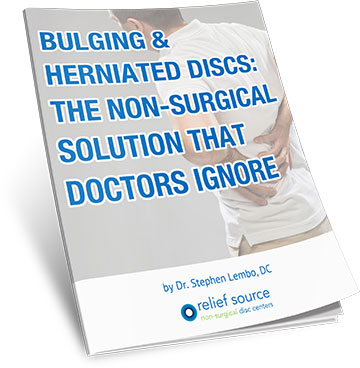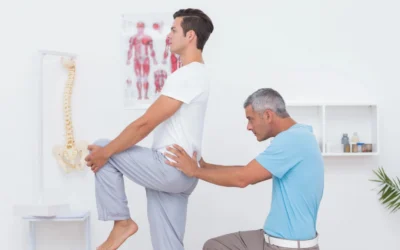Chronic back pain can affect every aspect of your life, from work to recreation, and can lead to frustration when it seems like nothing provides lasting relief. If you’re suffering from conditions like herniated discs, bulging discs, sciatica, or spinal stenosis, it may feel like back pain is simply a part of your daily routine. However, managing chronic back pain doesn’t always require surgery or medication. In fact, there are several lifestyle habits and small changes that can make a significant difference in how your body handles pain and stress.
At Relief Source Non-Surgical Disc Centers, we focus not just on providing advanced, non-surgical treatments, but also on educating our patients about habits that can prevent and manage back pain over the long term. In this blog post, we’ll share key lifestyle habits that can help you reduce pain, improve mobility, and take back control of your life.
1. Stay Active with Regular Exercise
Exercise might seem counterintuitive when you’re experiencing back pain, but staying active is one of the most effective ways to alleviate pain and improve spinal health. Low-impact exercises, like walking, swimming, and cycling, can strengthen the muscles that support your spine, improve flexibility, and reduce stiffness.
Strengthening your core muscles—those in your abdomen, hips, and lower back—is particularly important. A strong core helps support the spine, alleviating strain and preventing future injuries. At Relief Source Non-Surgical Disc Centers, we encourage patients to incorporate exercises like planks, bridges, and bird dogs into their routines, which target the core while being gentle on the back.
2. Maintain a Healthy Weight
Carrying excess weight, especially around the abdomen, puts extra strain on your lower back. This added pressure can worsen chronic back pain, especially in individuals with conditions like herniated discs or degenerative disc disease. Maintaining a healthy weight through proper diet and exercise is essential for reducing the stress on your spine.
Eating a balanced diet full of fruits, vegetables, lean proteins, and whole grains not only helps you manage your weight but also provides your body with the nutrients it needs for tissue repair and overall health. At Relief Source Non-Surgical Disc Centers, we work with patients to develop lifestyle plans that promote healthy weight management and support long-term healing.
3. Mind Your Posture
Good posture plays a significant role in preventing and managing chronic back pain. When you slouch or hunch forward, it can lead to spinal misalignment, strain on the discs, and muscle fatigue. On the other hand, maintaining a neutral spine position helps distribute weight evenly, reducing pressure on your back.
Here are a few key tips for maintaining proper posture:
- When sitting, keep your feet flat on the floor, your knees at a 90-degree angle, and your back supported by the chair.
- When standing, keep your shoulders aligned over your hips and avoid locking your knees.
- If you’re working at a desk for long periods, take frequent breaks to stand, stretch, and move around.
Small adjustments to your posture throughout the day can have a big impact on how your back feels.
4. Incorporate Stretching and Flexibility Training
Tight muscles, particularly in the lower back, hips, and hamstrings, can exacerbate back pain. Stretching regularly helps improve flexibility, reduces muscle tension, and increases your range of motion. This is especially important for individuals with conditions like sciatica, where tight muscles may put additional pressure on the sciatic nerve.
Incorporating gentle stretches into your daily routine can help reduce pain and prevent muscle stiffness. Some effective stretches for back pain relief include:
- Cat-Cow Stretch: This stretch improves flexibility in the spine and helps relieve tension in the back.
- Child’s Pose: A gentle stretch for the lower back and hips.
- Hamstring Stretch: Stretching the hamstrings can help alleviate tension in the lower back and reduce the risk of sciatica.
A regular stretching routine can go a long way in preventing flare-ups and improving overall spinal health.
5. Get Adequate Sleep
Sleep is crucial for the healing and recovery of your body, including your spine. Lack of sleep can heighten your sensitivity to pain, and sleeping in the wrong position can further aggravate back pain.
To support your spine while sleeping:
- Try sleeping on your side with a pillow between your knees to maintain spinal alignment.
- If you prefer sleeping on your back, place a small pillow under your knees to reduce pressure on the lower back.
- Avoid sleeping on your stomach, as this can place strain on your neck and spine.
Creating a sleep-friendly environment and focusing on proper sleep posture can help you wake up feeling refreshed and less likely to experience back pain.
6. Manage Stress
Chronic stress can contribute to back pain by causing muscle tension, inflammation, and pain sensitivity. When you’re stressed, your muscles may tense up, especially in the neck, shoulders, and lower back. Over time, this muscle tightness can exacerbate existing pain.
Incorporating stress-reducing activities into your daily routine can help reduce the impact of stress on your body. Practices like deep breathing, meditation, yoga, or even simple relaxation techniques can help calm your nervous system and relieve tension in your muscles.
7. Use Heat and Cold Therapy
Heat and cold treatments are simple yet effective ways to manage back pain at home. Cold therapy, like ice packs, can help reduce inflammation and numb sharp pain, especially after an injury or flare-up. Heat therapy, such as heating pads or warm baths, helps relax tight muscles and increase blood flow, which can aid in healing.
Be sure to apply heat or cold in 15-20 minute intervals and never apply either directly to the skin—always use a cloth to protect your skin from burns or frostbite.
8. Consider Non-Surgical Treatment Options
If you’re already experiencing chronic back pain and want more than just lifestyle changes, Relief Source Non-Surgical Disc Centers in Massapequa, NY, offers non-invasive, cutting-edge treatments that can help you manage your pain. Our Back Restore Renewal System, which includes DRX 9000 Non-Surgical Spinal Decompression, Class IV Warm Laser Therapy, and Softwave Therapy, is designed to treat the underlying causes of chronic back pain while helping you avoid surgery and medication.
These treatments, combined with lifestyle changes like proper posture and regular exercise, can offer lasting relief and promote long-term spinal health.
Start Your Journey Toward Pain Relief Today
If you’re tired of living with chronic back pain and want to take the first step toward a pain-free life, contact Relief Source Non-Surgical Disc Centers today. Our team of experts is dedicated to helping you find a customized, non-invasive treatment plan that works for your unique needs
Call us at (516) 882-6337 or visit our clinic at 5254 Merrick Road, Suite 1, Massapequa, NY 11758.
Take charge of your health and start your journey toward long-term back pain relief today!
- Lifestyle Habits That Can Help Prevent and Manage Chronic Back Pain - April 9, 2025
- The Importance of Posture in Managing Chronic Back Pain: Tips and Strategies for Relief - April 9, 2025
- Modern Non-Surgical Treatment Technologies - April 9, 2025





